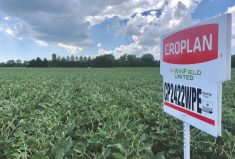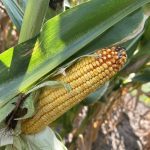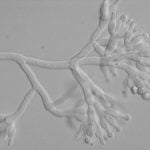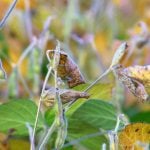An intensively farmed crop such as potatoes always demands diligence in production. In addition to irrigation and finding suitable rotation crops, growers are constantly looking for an upper hand in dealing with nutrient issues and measures aimed at improving soil health and overall production. That might be where there’s an intriguing fit for a relatively new inoculant that reinforces root development and nutrient uptake through the introduction of mycorrhizal fungi.
The existence of mycorrizhal fungi and their relationship to healthy soils are certainly nothing new. Farmers who are dedicated to no till are often the most familiar with the benefits of mycorrhizae, a network of filaments that colonize a plant’s root system and enable it to draw on sources of nutrients and water to which it might not otherwise have access. It also stimulates plant growth and can help accelerate root development.
Read Also

The slow evolution toward real-time variable rate fertilizer
We need to hit the “easy button” on variable rate fertilizer and move away from the default blanket application. But…
The use of this inoculant helps bridge that gap in root development and nutrient and water access and does so in fairly short order, compared to the longer-term process that comes with no-till farming. Katelyn Bruinsma, sales representative with Premier Tech Agriculture, has worked with six growers across Ontario, introducing the company’s MykePro Potato L liquid inoculants. The first MykePro products were introduced in 2002 for horticultural and landscaping sectors. From there, a product line was introduced for row-crop agriculture in 2008 and a liquid formulation for potatoes followed in 2011, with a reformulation launched in 2012.
Bruinsma says mycorrhizae are naturally occurring fungi which help plant development. The MykePro products provide a specific strain of the fungi which enables that plant to derive the most benefit by placing it at the right time in the right place at the right concentration.
“Mycorrhizae are important for soil health and contribute to creating a better, more conductive environment around the root zone for the good biology to grow, and that in turn helps generate better soil health,” says Bruinsma. “The mycorrhizae actually need a host plant to live off of — they work in symbiosis together, so the fungi live within the plant root hairs and they feed off of each other. If the plant dies, then the chance of survival decreases for those mycorrhizal fungi.”
The inoculant comes in a jug capable of treating 10 acres of potatoes. It can be tank mixed with a liquid fungicide application at planting. Placed next to the seed, it enhances existing mycorrhizal strains and places the most beneficial strain next to the potato. The only stipulation is that like most inoculants with a living biotic culture, MykePro Potato L should be used within six hours of mixing in the tank.
Any conditions?
The inoculant can be used in any soil type, and can actually help the potato root system overcome different challenges associated with different soils. The use of inoculants is geared to increasing the root system, therefore increasing the overall surface area of that system for nutrient and water absorption. In muck soils, the nutrients are tied up more, so having that mycorrhizal fungi there can help access those nutrients.
“In sandier soils, they don’t hold as many nutrients and water as well because sandier soils dry out quicker,” says Bruinsma. “So having a larger root system and mycorrhizal network in the soil can allow the plant to access more of that water and more of the nutrients.”
The use of MykePro Potato L has shown positive and consistent results during a four-year period tested in four different regions — the Maritimes, Quebec, Ontario and Maine. Data from more than 200 trials indicate an average yield increase of 29.5 cwt/acre or 9.8 per cent. One of the growers Bruinsma works with saw yield increases in some of his fields in 2013, “just enough to spark his interest and try it again.” In 2014 he increased his treated acres and saw a large increase in yield — 14.5 per cent on average.
Easy to see
From Jeremy Rood’s perspective, there’s no “hard-sell” on the use of mycorrhizal fungi or the MykePro inoculant — or its benefits. He operates Grand Bend Produce, with a farm, packaging plant and headquarters located just outside of Grand Bend, Ont. In all, he farms on a little less than 1,000 acres, with other fields located near Komoka, Mount Brydges, Strathroy, Exeter and Thedford. So when Rood says he’s seen significant success, it’s across a fairly broad area.
“We didn’t have success on every single variety that we tried it on (in 2013), but on at least 50 per cent we had success with it.” says Rood. “The varieties that weren’t successful, they weren’t any worse than the check, so it didn’t do any harm. But this past year (2014), we’ve had great success with it — every single variety demonstrated yield gain, and the crop was a bit earlier as well because of it. You could tell right off the bat with one of the first fields we planted we did the last 10 acres with it, and you could see right down the row around mid-season, right before flowering, they were four or five inches higher than those parts grown without the mycorrhizae.”
The plants were also a darker shade of green and appeared to be healthier overall. When Rood would pull a treated plant, he says it was apparent how much stronger the root system was, compared to an untreated plant. And in spite of the fact that his crops are irrigated, the plants fared much better with the faster growth.
“The crop was ready a week sooner, the size was there, and with the plants being that much bigger that much faster, it also helped out in the long run because it shaded out the weeds and it shaded out the ground so we didn’t have as much evaporation,” he says.
This article was originally published in the 2015 Potato Guide
















